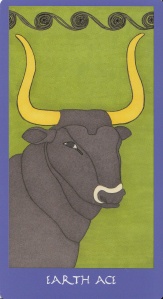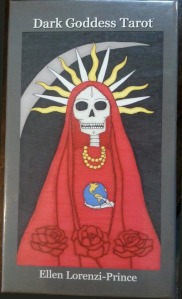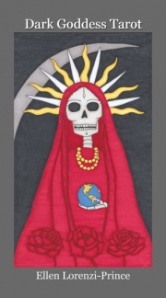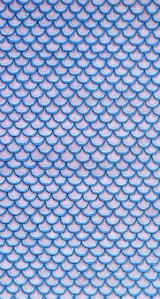Tarot of the Crone –
Third Edition
Author: Ellen Lorenzi-Prince
Artist: Ellen Lorenzi-Prince
Publisher: Arnell’s Art
2017
ISBN #978-0-9894739-4-1

Inspired by the ancient holy one. She is
grandmother, witch and hag. She has been
ignored or trivialized because she holds
powers that others fear or deny. Powers of
time and transformation, of death and shadow,
of wisdom and pain, of magic and wonder.
Ellen Lorenzi-Prince
I have followed this deck since its inception – as a handmade Limited Edition. To realize that this is the third birthing is absolutely amazing! The deck and companion book hold incredible power – power that we hold in our hands to help us to understand ourselves, to understand life, and to help others understand themselves and their lives. It is the power of transformation, the literal power of the Crone.
Tarot of the Crone is a 78 card deck with an 85 page companion book. Deck and book come packaged in a hard cardboard, life top box. The box has a black background, with a picture of the Star on the cover. The bottom of the box features pictures of the Priestess and the Wheel.
The Major Arcana follow traditional titles, with the following exceptions: High Priestess/Priestess, Hierophant/Tradition, Lovers/Crossroads, Wheel of Fortune/Wheel, Hanged Man/Sacrifice, and Judgment/Calling. Justice is VIII, Strength is XI. The suits are Wands, Cups, Swords and Disks. The Court cards are entitled Beast, Witch, Grandmother, and Shadow.

The cards are 3” by 4 ½”, with a glossy surface. The card backs are a solid black, which fits in well with the journey of transformation that this deck represents (the Crone’s journey). The card faces show a ¼” black border, with the card number/title in white at the bottom of the card. Roman numerals are used for the Major Arcana, with the numbers for the Minor Arcana written in text.
The companion book dedicates the deck to Hekate. In the front of the book is an explanation of who the Crone is, and how to meet her/bring her into your life. The Major Arcana cards are said to represent times when the Crone is speaking directly to the soul of the Seeker. The Minor Arcana represent qualitied or aspects of our magical, emotional, mental and mundane lives. There is a listing of the colors used in this deck, and what they symbolize. Each suit is based on two colors (along with black and white): Wands – Red and Yellow, for Power and Will, Cups – Red and Purple, for Feeling and Soul, Swords – Blue and Yellow, for Mind and Ability, Disks – Green and Brown, for Life and Flesh.
The prelude to the Minor Arcana defines the elements and the numbers, as well as the Faces (Court cards). Beast is defined as the primal instinct of the power. The wild and whole expression of the element. Witch is defined as the focused use of the power concerned with fulfilment and expression of self. Grandmother is defined as the mature expression of the power concerned with family and community. Shadow is defined as the element’s overdone, destructive and devouring power.
Each card is presented with a poem, an explanation of the cards energy, and a small, full color photo. (Note: Two cards are presented, with the full color photos following, side by side.) For the Magician, the poem reads:
I am the Something
That comes from nothing
I am the Mistress of Illusion
I am the Mistress of Reality
I am the One
Who passes between
 The Fool is said to look beneath the everyday world. The Fool accepts the risk of becoming lost in the Void. Lorenzi-Prince goes on to say that we need to become formless and timeless to create a new future.
The Fool is said to look beneath the everyday world. The Fool accepts the risk of becoming lost in the Void. Lorenzi-Prince goes on to say that we need to become formless and timeless to create a new future.
 The Magician is represented as a mask with living eyes. This is a force that manifests out of the void and into the world. Here we find will and confidence. We are reminded, however, that the mask is also an illusion. The Magician knows reality and illusion, and crosses freely between them.
The Magician is represented as a mask with living eyes. This is a force that manifests out of the void and into the world. Here we find will and confidence. We are reminded, however, that the mask is also an illusion. The Magician knows reality and illusion, and crosses freely between them.
 Crossroads features faces in shadow, with tripe Hekate standing at a crossroads on a moonless night. Hekate is not there to show us the way, she is there to challenge our path.
Crossroads features faces in shadow, with tripe Hekate standing at a crossroads on a moonless night. Hekate is not there to show us the way, she is there to challenge our path.
 The Seven of Wands is associated with the theme of Risk. The cloaked figure stands amidst flames and lines of raw power. She embraces danger in the hope of further achievement. We are encouraged to trust our experience, and take educated risks.
The Seven of Wands is associated with the theme of Risk. The cloaked figure stands amidst flames and lines of raw power. She embraces danger in the hope of further achievement. We are encouraged to trust our experience, and take educated risks.
 The Beast of Wands is associated with the theme of Cat. A sleek black cat dominates this card. The cat combines instinct and intelligence to achieve her desires.
The Beast of Wands is associated with the theme of Cat. A sleek black cat dominates this card. The cat combines instinct and intelligence to achieve her desires.
 The Ace of Cups is associated with the theme of Grace. Lorenzi-Prince reminds us here that at the root of all emotion is the ability to feel.
The Ace of Cups is associated with the theme of Grace. Lorenzi-Prince reminds us here that at the root of all emotion is the ability to feel.
 The Five of Swords is associated with the theme of Contradiction. I love the five abstract swords in the card, and how they clash! We are asked to look at not only the other side of a situation, but to turn the situation inside out and look at that. Questions have a tendency to lead to more questions.
The Five of Swords is associated with the theme of Contradiction. I love the five abstract swords in the card, and how they clash! We are asked to look at not only the other side of a situation, but to turn the situation inside out and look at that. Questions have a tendency to lead to more questions.
 The Grandmother of Discs is associated with the theme of Homemaker. The small, loving acts of the Grandmother sustain the home, the community, and the world.
The Grandmother of Discs is associated with the theme of Homemaker. The small, loving acts of the Grandmother sustain the home, the community, and the world.
Tarot of the Crone continues to be the story of the transformation of the Crone. The white borders of the second edition have been replaced with (more appropriate, IMHO) black borders. The original poems are included, along with the interpretations that appeared in the second edition. Published in conjunction with the illustrious Arnell Ando, the deck, companion book and black box scream quality and professionalism. IMHO, this is a collectors item, and a must have for ritual work of many types. And yes – it flows well as a divinatory deck too!
© March 2017 Bonnie Cehovet
Reproduction prohibited without written permission from the author.





















